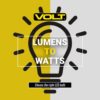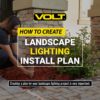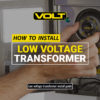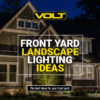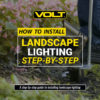Introduction to landscape lighting
Installing low voltage landscape lighting is a safe and easy do-it-yourself project for most homeowners. That said, it’s important to understand some basics before starting your project – starting with how to select the best landscape lighting fixtures to enhance your home and outdoor living areas.
What are the main types of landscape lighting?
With little risk of electrical shock and cable that can be directly buried in shallow trenches (minimum 6″ deep), low voltage landscape lighting (12V) is generally preferred for residential use.
Line voltage (120V) is found in common household electrical outlets. This type of landscape lighting requires a licensed electrician to install. Although it can also be appropriate for larger homes, it is typically used in commercial, security or municipal applications.
What are the main components of a landscape lighting system?
The first major component of a landscape lighting system is the fixture. It not only houses the light source but helps to direct the light toward the area you wish to illuminate.
The next major component of a 12-volt lighting system is the low voltage transformer. This is the 120-volt power supply that converts line voltage current down to 12-volt AC.
The final two components of your system are wire and wiring connectors. These carry the power out from the transformer to the fixtures in the yard.
What are the common types of landscape lighting fixtures?
- Spotlights are the most common type of landscape light. These highlight specific key features throughout your landscape, which is why they’re also referred to as accent lights.
- Any spotlight with a 60-degree beam angle or wider is known as a flood light. These use large pools of light to illuminate broad areas with a single fixture.
- Path lights are used as guiding lights to illuminate walkways, driveways, patios and more. They can also be used in gardens or large flower beds to illuminate areas with lots of ground vegetation.
- Hardscape fixtures are low-profile fixtures that are used to highlight specific architectural features on your patio, outdoor kitchen, retaining walls and so on.
- In-ground lights are used in up-lighting applications that require the light source to remain hidden.
- Underwater lights are specifically designed to be fully or partially submerged year-round. They are typically used in fountains or ponds.
- Downlights are spotlights or flood lights that are designed specifically to be oriented in a downward position.
- Specialty lights are designed for specific tasks that may be hard to illuminate with other standard fixtures. These lights include bistro lights, tiki torches, and even decorative area lights.
What are the main fixture classes of landscape lights?
- Integrated fixtures have an LED board built into them, so there’s no bulb to install. The downside to integrated fixtures is that if one should fail, then the entire fixture has to be replaced as opposed to just a bulb.
- Lamp-ready fixtures use a bulb, which allows for much more customization in terms of brightness (lumens), color temperature and beam spread. And usually if a light goes out, you just need to pop in a new bulb.
What are some important landscape lighting terms?
- Beam spread or beam angle refers to the spread of light from the luminaire. This is chosen based on the task at hand and how wide the light needs to spread. Sometimes the beam spread is fixed based on the fixture’s unique shape, as it is with area lighting.
- Color temperature is measured in Kelvin and refers to how warm (yellowish) or cool (bluish) the lighting appears to be. Most lighting ranges from as low as 2000K (which is very warm, like candlelight) up to 5000K (which is a stark whitish blue). Typical applications call for warm white 2700K light, which is most similar to that of traditional incandescent lighting.
- Lumen output is the amount of illumination provided or simply how bright it is.
- Wattage is the amount of energy used by a fixture and is an important number to keep track of. Add up the wattage of all of your fixtures or bulbs and then determine the appropriate transformer for that wattage. We recommend not exceeding 80 percent of a transformer’s capacity. If you don’t have at least a 20 percent buffer from maximum capacity, you will need to step up to a larger transformer.
- Efficacy is a ratio that compares power consumption to light output. This is measured in lumens per watt. The reason efficacy is important is that a lot of bulbs are listed by wattage equivalents, which is how brightness was traditionally understood. Because LED bulbs are so efficient, they can produce a lot more lumens while utilizing much less power or wattage. For example, a 5-watt LED bulb may have a 30-watt halogen equivalence due to its high efficacy.
How are landscape lighting fixtures mounted?
There are various fixture mounting options to choose from. Most of the time, you’ll just need a simple ground stake. However, if that’s not an option in your desired location, you can use a surface mount, gutter mount or other specialized mounts.
What is the best landscape lighting?
That’s an easy one. With in-house engineers and lighting experts who use the latest LED and control technologies, VOLT® designs, manufactures and sells the landscape lighting industry’s best products. That’s why we have hundreds of 5-star reviews.
VOLT® fixtures feature premium internal components and are constructed of solid brass or copper that patinas beautifully as it ages. There’s no paint or powder coating to wear off, peel or corrode. Competitors’ aluminum fixtures may be cheaper up front, but they’ll inevitably rust and need to be replaced in a few years. However, professional quality VOLT® products are built for a lifetime of beauty and durability. Plus, our Certified Lighting Experts are on-hand seven days a week to answer any questions you may have; give them a call at (813) 978-3700.
